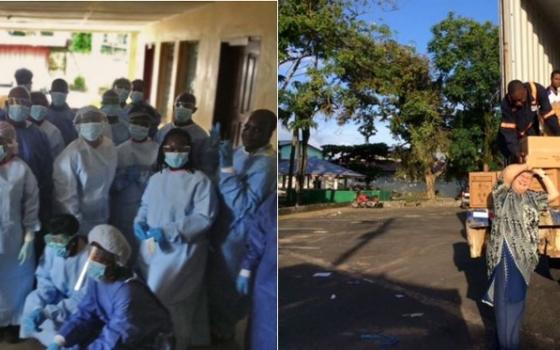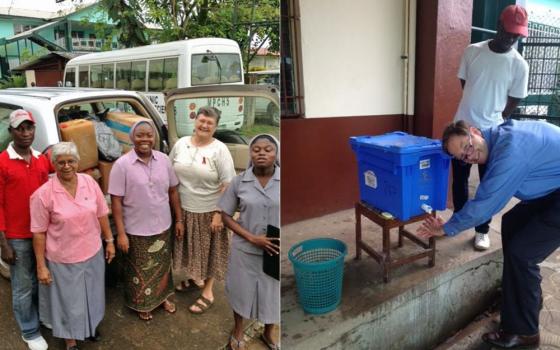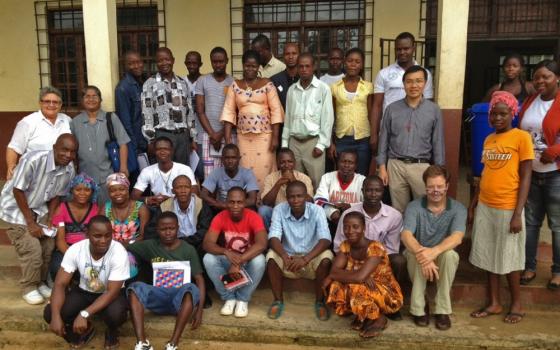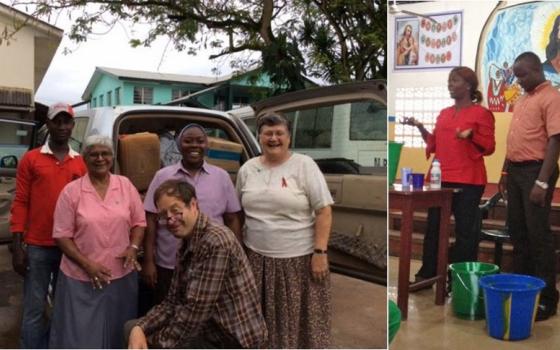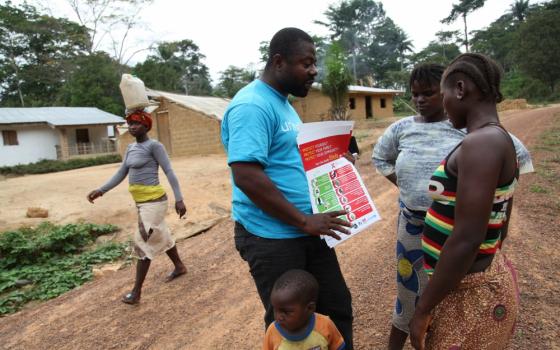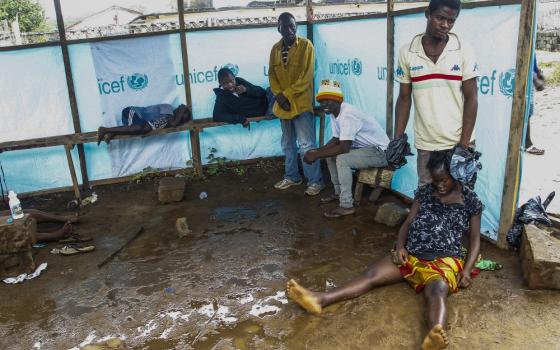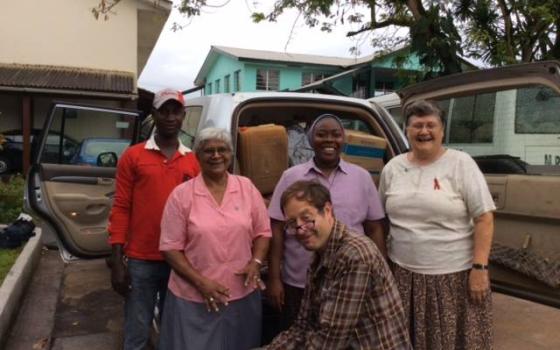Catholic organizations worked their networks to provide care from the beginning
Two months after the Ebola outbreak spiraled out of control in West Africa, small signs of change are beginning to appear in the Liberian capital of Monrovia: buckets of diluted chlorine for hand washing are outside many buildings, Ebola-specific of treatment centers are opening, and now people bow to greet each other from a distance instead of embracing or shaking hands. Slowly, proper information and education is trickling out to even the most remote areas, contributing to a growing understanding of the deadly virus.
In the early days of the outbreak, people were scared to go to hospitals and clinics. “They didn’t trust the health system,” explained Sr. Barbara Brillant of the Franciscan Missionaries of Mary. “Because why? Health workers were dying, and they thought these are the people who are giving it to us, not trying to save us,” she said. Brillant is the president of the Mother Patern College of Health Sciences at the Stella Maris Polytechnic University.
As fear and confusion gripped the country over how to deal with the killer virus, Liberia’s already shaky health system collapsed. In small local clinics, sometimes entire staffs of eight or 10 people were killed within days. The Catholic church’s biggest hospital in the capital of Monrovia, which employs over 185 staff, was forced to close after nine of their top doctors and administrators died of the virus.
According to World Health Organization statistics from Oct. 3, there have been 7,492 Ebola cases and 3,439 deaths in the current outbreaks. Liberia has been the hardest hit, accounting for 3,834 cases of Ebola and 2,069 deaths.
“The crisis now is health services have come to a standstill,” said Brillant. Compounding the problem, in August, borders closed and cargo planes refused to land, meaning that things like personal protective equipment (PPEs), the spacesuit-like outfits that protect health workers from the virus, could not arrive. Some organizations pulled their international staff out of the country, but other experts and doctors who wanted to come to Liberia to assist found land borders closed and airports not functioning.
“This past month it’s been a disaster, and the government knows this,” said Brilliant. “Having said that, it’s understandable, because coming out war, the health system was not strong, there was no supply chain management. It was a disaster waiting to happen and it’s happened. The health system is shaken, not dead, but shaken.”
(Liberia’s civil war, when Charles Taylor's National Patriotic Front of Liberia overran the country, lasted from the late 1980s to 2003, when Taylor fled the country for Nigeria. Approximately 250,000 people were killed during the fighting, and the country’s infrastructure was decimated.)
As the country struggled through the early days of the virus in August and September, the Catholic church kicked their network into high gear. The church has 18 clinics and hospitals in the diocese of Monrovia. Even in the worst days of the outbreak, they kept 15 open. Across Liberia, there are approximately 600 hospitals and clinics; 300 are privately run and faith-based, Brillant said.
The church’s clinics were able to stay open because of “good staff and committed people,” Brillant explained by Skype from Monrovia. Still, the clinics were not operating in ideal circumstances. “These clinics were running dangerously, there’s no other way to describe it,” Brillant said. “They didn’t have PPEs, so they had to do the ‘no touch’ approach. They just had to ask the patients what their signs and symptoms are and then guess based on that. There was no touching, only for maternity cases or cases that are really bad.”
“One of the hardest things is to train healthcare workers to provide ‘no touch’ care,” explained Dr. Tim Flanigan, an infectious disease specialist at Brown University and a deacon at Tiverton parishes St. Christopher and St. Theresa in Rhode Island. Flanigan took a leave of absence and flew to Liberia at the beginning of September to provide organizational assistance.
Liberia traditionally has a warm and effusive culture, with handshakes, hugs and double-cheek kisses being common ways of greeting friends and strangers alike. The “no touch” policy is trying to temporarily stop that. The proper greeting now is now a bow from a distance away, said Brillant. Some churches have also stopped giving communion in order to minimize contact.
This has been especially hard for family members and health workers. “As health professionals we always want to show our care and concern,” Dr. Flanigan wrote in an email. “We tend to do this by touching our patients. But in the case of Ebola you cannot do that. It is hard and challenging, but actually critical that we show patients that we care and support them even though we cannot touch them.”
In Liberia, universities and schools closed as the country tried to deal with the crisis. Brillant immediately directed all of her staff at the health college to begin training other health workers on appropriate safety precautions to deal with Ebola patients. Their staff also retrained HIV response teams to assist with Ebola training, including proper methods for protective clothing and cleaning.
“We also have a second team which is made up of teachers and social workers, because the social and psychological services are very important,” Brillant added. “All the schools are closed, so we’re trying to train the teachers. We’ve got a health response and a non-health response. The health response goes to clinics and hospitals. The non-health team does social mobilization. They go to communities, parishes, schools. . . . They’re doing awareness on Ebola. What is it? How do you get it? How do you not get it?”
Brillant said the health response team has now reached many of the health workers at Catholic institutions inside Monrovia, and will spend the next month going to clinics outside of the capital. They will also follow up on clinics where they have already trained workers. The non-health team will put a large emphasis on outreach in the communities, to try to stop the exponential spread when an infected person is not brought to the treatment center and infects the rest of the family.
It took almost a month for the international community to understand the size of the crisis in Liberia. After desperate pleas from President Ellen Johnson-Sirleaf, U.S. President Barack Obama finally took action on September 15, promising 3,000 troops and 17 treatment centers with 100 beds each. The United Nations estimates that the country needs $988 million to contain the disease, but countries have only pledged about 26 percent of this amount. The World Health Organization said Liberia alone needs at least 1,500 foreign health workers to contain the virus.
The influx of aid, both monetary and supplies, means while the crisis is far from over, the country is starting to provide the correct response, Brillant explained. One major difference is the construction of Ebola Treatment Units (ETUs), located a little bit outside communities and are constructed solely to deal with Ebola cases. This means that now patients with Ebola are being treated in places that are equipped to deal with the disease, including proper protective equipment and trained staff. Additionally, the patients are not going to the regular hospitals or clinics and infecting health workers or other people at the clinics. It was a struggle to get the funding and expertise needed for ETUs, and many ETUs filled up within hours of opening.
“I think I’ve seen a change slowly, minutely it’s improving,” Brillant said on October 1. “People are still afraid, they still have that fear.”
“We have to gain the confidence of the public again,” she said. “They’re starting to trust again. I think people also realize that [now] we have ETU units, treatment centers which are better set, better staffed and have better care. Before they said, you go there, you die. Well, yes, because they came in the last stages of the disease. But if you report yourself, early your chances of survival are now almost 60 percent.”
In past outbreaks, the fatality rate is anywhere from 25 percent to 90 percent, according to the World Health Organization. If Ebola is treated in the early stages, and the patient can stay properly hydrated and keep the fever down, they have a much better chance of survival.
Part of the change is due to the tireless social outreach, which has helped bring about a growing cultural understanding of the virus. “Community engagement is key to successfully controlling outbreaks,” the World Health Organization said in its recommendations. Before, people would hide sick relatives from health workers. Now, they are more likely to report when someone has a fever.
“You have some people saying Ebola doesn’t exist, but I think people are getting a little better,” said Brillant. “Having Dr. Tim as part of our team has helped tremendously, because he talks about the actual facts of Ebola. If you don’t touch someone, how are you going to get it? Ebola doesn’t jump from one person to the other. He’s alleviated a lot of those fears with his knowledge.”
Strain on regular healthcare
The emphasis now is on reopening shuttered hospitals and clinics to deal with non-Ebola cases. Thousands of people are dying because of easily preventable diseases because they can’t get regular treatment anywhere, explained Brillant. Liberia’s Health Ministry is emphasizing pediatric health and maternal health is the first two goals.
“People are dying of malaria, and we had a measles outbreak in one area [though measles was previously under control],” said Brillant. “If you have a serious car accident and break a leg, there is nowhere to set that leg.”
Brillant estimates by the end of October there will be a decrease in the number of new Ebola cases, and hopefully by January the virus will be under control, though it could take much longer to eradicate all new cases altogether. Still, organizations are desperate for cash donations and medical supplies.
One thing that didn’t surprise her was the rapid response of women religious and Catholic organizations, which quickly started divvying up tasks.
“With the Franciscan Missionaries of Mary, we have five sisters here and all are working on Ebola. One is a teacher so she’s coordinating with schools,” said Brillant. Sr. Mary Laurene Browne of the Bernadine Sisters, who is the president of the Stella Maris Polytechnic, worked with Mary Rizzo, the assistant director of development and mission advancement of Bernadine Sisters in Pennsylvania, to coordinate $150,000 in donations and more than $2 million worth of medical supplies. The Bernadine Sisters were one of the first groups to start shipping massive amounts of medical supplies to Liberia because they already had contacts on the ground.
The list goes on: For one, the Missionaries of Charity (Mother Teresa’s congregation) work with orphaned children whose parents died from Ebola and whose remaining family won’t take them back because they are scared, even though the children are negative for the disease.
“The Consolata Missionary Sisters are doing fantastic social mobile outreach. The Salesian Sisters [of St John Bosco] are heading up youth programs, training youth to go from house to house and community to community. The Society of African Missions is here, as well as Caritas International and Catholic Relief Services, I could name more but I’d be here all day,” Brilliant said. Many other Catholic organizations and local bishops are assisting in the effort as well.
In the chaos of a developing disaster in an impoverished country, the women religious and Catholic organizations were at the forefront of organizing a response, Brillant explained. “We live here, we’re from here, I’ve been here for 36 years,” she said. “I think that’s why people look to churches. Churches are here. You can have the best international non-governmental organization in the world, but you know they’re going to leave. We’ve used the foundation of the church to get out and mobilize and treat early. That’s the blessing we have.”
You can follow the work of Sr. Barbara Brillant and the medical donations from the Bernadine Sisters here. For updated coverage on the Catholic response to the Ebola crisis, follow Dr. Tim’s blog.
[Melanie Lidman is Global Sisters Report correspondent for Africa and the Middle East.]
Related - Not whether to help, but how by Dan Stockman
